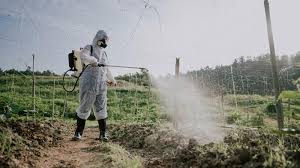Rick Relyea points out a significant issue in pesticide research, highlighting that economic interests have largely driven the focus of studies toward targeted pests, while non-target species, which represent the immense biodiversity of our planet, have been largely neglected. “Due to economic interests, most pesticide research has been centered on targeted pests, neglecting non-target species which encompass the vast biodiversity of our world,” Relyea explains. This narrow focus means that the broader ecological impacts of pesticides on non-target species remain underexplored, leaving gaps in our understanding of how these chemicals affect the full spectrum of life they come into contact with.

In addition to addressing the oversight of non-target species, Relyea and his team have ventured into a relatively uncharted area of toxicology. “We also investigated whether pesticide tolerance could be rapidly induced in a non-target animal, an area that hasn’t been explored because it’s not the conventional approach to toxicology tests,” he notes. This innovative approach aims to explore whether non-target animals can develop tolerance to pesticides more quickly than previously thought, potentially shedding light on new aspects of pesticide impact and resistance. By expanding research to include these novel inquiries, Relyea and his team hope to contribute to a more comprehensive understanding of pesticide effects and promote more sustainable practices in pest management.
Redefining Toxicology Research
Conventional toxicology tests typically aim to determine the lethal dose of a pesticide through a single exposure, providing a snapshot of the immediate dangers posed by these chemicals. However, Rick Relyea and his team adopted a different methodology by initially exposing wood frogs to sublethal doses. This approach mirrors real-world scenarios where animals are repeatedly exposed to small amounts of pesticides over time. “In nature, this is how animals are typically exposed,” Relyea explained. “Animals living near agriculture, lawns, and landscaping are likely receiving numerous small doses of pesticides.”
Through this method, Relyea and his team discovered that wood frogs could rapidly develop a higher tolerance to several commonly used insecticides within just a few days. This finding is significant because it suggests that animals can adapt to the presence of pesticides more quickly than previously understood. “The question is, what effect does that have on the animals? Our research found that wood frogs can increase their tolerance to several commonly used insecticides within days,” Relyea noted. By highlighting the capacity for rapid adaptation, this research underscores the need to consider sublethal exposures and their potential impacts on wildlife in environmental risk assessments.
Investigating Pesticide Tolerance in Frog Populations
The team studied 15 populations of wood frogs from western Pennsylvania and eastern New York, testing their tolerance to three common insecticides: carbaryl, chlorpyrifos, and diazinon. They compared the results of frogs initially exposed to no pesticide with those exposed to sublethal concentrations before being subjected to lethal doses. The findings were revealing, showing that nearly half of the populations developed rapidly inducible tolerance.
- Study Populations: 15 populations of wood frogs from western Pennsylvania and eastern New York.
- Insecticides Tested: Carbaryl, chlorpyrifos, and diazinon.
- Exposure Groups: Frogs exposed to no pesticide vs. those exposed to sublethal concentrations before lethal doses.
- Results: Nearly half of the populations developed rapidly inducible tolerance.
“We believe this mechanism allows animals to evolve pesticide tolerance more quickly over generations,” Relyea noted. “If tolerance is initially induced by a sublethal exposure, it helps protect the population over generations, as that tolerance becomes genetically favored. Future generations wouldn’t need to be exposed to sublethal doses to exhibit increased tolerance.” This discovery highlights the potential for rapid evolutionary adaptation in wildlife populations facing ongoing pesticide exposure, emphasizing the need for updated approaches in toxicological testing and environmental conservation strategies.
The Limits and Implications of Increased Tolerance
However, increased tolerance has its limits. “We don’t want people to think that pesticides pose no threat to non-target animals,” said Jessica Hua, Ph.D., associate professor in the Department of Forest and Wildlife Ecology at the University of Wisconsin-Madison. “They can still die. There is a difference between being more tolerant and being impervious to pesticides. Additionally, our research shows that while low levels of pesticides can induce tolerance, this tolerance can be costly and impact the ability of animals to withstand other threats, like diseases.”
Future Directions in Pesticide Research
This research is just the beginning of what could be a much larger and more comprehensive study. “We hope our findings pave the way for further studies,” said Jason Hoverman, Ph.D., professor of vertebrate ecology in the Department of Forestry and Natural Resources at Purdue University. “There are numerous questions that remain unanswered and many avenues to explore. Can pesticide tolerance be induced in other amphibian species, or is this phenomenon unique to wood frogs? Additionally, it would be crucial to investigate if other non-amphibian animals, such as insects, birds, or even mammals, can develop similar tolerance mechanisms. Understanding the breadth of this adaptive response could significantly influence how we approach pesticide usage and regulation. Furthermore, we must examine whether this induced tolerance can occur with other types of pesticides beyond the three we studied – carbaryl, chlorpyrifos, and diazinon. Each pesticide has a different mode of action, and it is essential to determine if the frogs’ tolerance can extend to these various chemical structures or if it is specific to certain compounds. Expanding this research will not only enhance our understanding of ecological and evolutionary processes but also inform better management practices to protect wildlife from the unintended consequences of pesticide exposure.”

Conclusion: New Insights into Rapid Adaptation
“Dr. Relyea and his team have provided valuable insights into how amphibian species can rapidly adapt to environmental threats and pass that adaptation down through generations,” said Curt Breneman, Ph.D., dean of Rensselaer’s School of Science. “I look forward to seeing future results from this research as we also explore ways to reduce environmental toxins.” This study underscores the importance of broadening the focus of toxicology research to include non-target species and the potential for rapid adaptation in response to environmental pressures.
More on:
- https://www.micro2media.com/the-most-endangered-fish-are-the-least-studied/
- https://www.micro2media.com/breakthrough-in-bioplastics-barley-and-sugar-beet-offer-hope-for-a-plastic-free-future/
- https://science.rpi.edu/biological-sciences/news/researchers-find-frogs-can-quickly-increase-their-tolerance-pesticides
- https://www.sciencedirect.com/science/article/abs/pii/S0166445X24001152